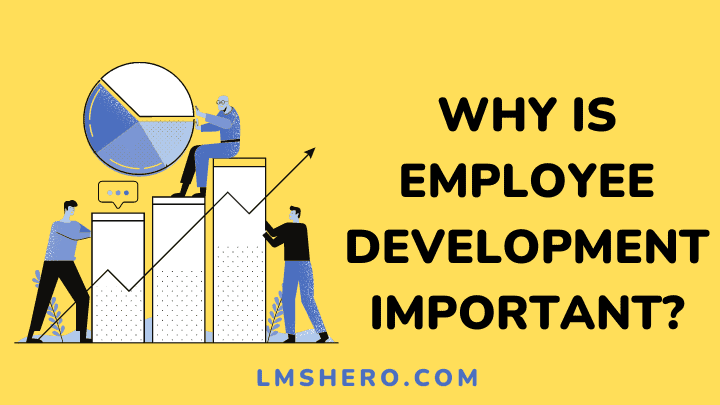Employee development provides you with the skills needed to help your company grow. If you are a professional looking for both personal and professional growth, then you are in the right place.
The growth of an organization is directly influenced by the ability of the experts working within it. It is important to invest in employee development to improve their capabilities, work efficiency, and commitment to the organization.
This article aims to help executives and managers understand the importance of employee development, as well as the best methods to create learning opportunities daily.
What is Employee Development and Why is it Important?
The term “employee development” has a wide range of meanings. However, it is commonly defined as the process of increasing an employee’s capacity to achieve both personal and organizational goals.
It is a conscious effort taken by an organization to help its employees become better and more capable at their jobs. Since most people agree on this, training new employees should be an essential part of any business plan.
Businesses can achieve this through on-site training, organizational, or online training.
Below are some benefits of employee development:
1. Improves Employee Effectiveness and Performance
A high-performance workforce ensures business success. A high-performance workforce is one that not only meets the requirements of the job but also seeks to continuously improve.
High performers are those employees who demonstrate the highest levels of productivity, customer usage, retention, and profitability. Employee training is key to improving employee effectiveness and performance.
2. The Company Retains its Competitive Advantage
There is no denying that employee development and training are important.
Besides, business is all about creating and sustaining a competitive advantage. With increased globalization, technological advances, and more demanding customers, retaining key employees is more important than ever.
Organizations want to retain and keep their employees and for this reason, they need to develop them. If the employees are happy and fulfilled by their development opportunities, then there’s a huge possibility that they’ll remain with the organization.
Employees who are empowered with the right skills also give their employers an edge over competitors.
3. Keep Business Skills Up-To-Date with Trends
The world of business is constantly evolving. There are always new trends emerging that can enhance your skills, no matter how good you are at your job.
Employees at the highest level of skill help businesses stay on top of trends and remain competitive in the business world.
Without a continual focus on employee development, even highly successful businesses will suffer. For employees to continue providing value to a company, they need training and education.
4. Encourages Better Handling of Unexpected Situations
Employee development ensures that teams and organizations can respond to change and challenges.
Knowing how to think strategically, and acting strategically to meet challenges head-on will help the organization minimize disruptions and be more effective overall.
As a result of the experience that well-trained employees accumulate, they can impart that knowledge to the rest of the company. This can then lead to better handling of unexpected future situations that may arise.
5. Enhances Teamwork and Collaboration
Through employee development, teams will be able to interact more effectively and be more creative.
A company’s primary goal is to instill its vision, mission, and values among its employees. This can only happen if the employees make use of their creativity, innovation, creativity, and commitment.
People who work together and share a common goal achieve more. Personal development also ensures that employees are growing intellectually, emotionally, socially, and professionally on a daily basis.
6. Enriches the Work Environment
Training or employee development is the process of increasing an employee’s ability to do a job through systematic education and training programs.
Both the employee and the organization will benefit from a good training program that improves the employee’s work ethic and attitude.
It also can help to fill in gaps in technical knowledge, build competency for new projects that come along the way, and also improve retention rates.
7. Creates Better Lines of Communication
Employee development and training can provide better lines of communication within the organization. This development provides employees with the tools to ask the right questions. It also helps employees to take initiative, solve problems, and be able to better explain what is being discussed.
Employees who feel they are growing and acquiring new knowledge will feel more valued and respected by their managers and organizations.
Educating employees will increase the employees’ self-confidence and self-esteem, which directly affects employee loyalty through job satisfaction.
8. Reduces Employee Turnover Rate
Good employee development creates knowledgeable, motivated people. Experts estimate that 75% of the lost turnover rate can be attributed to employee dissatisfaction.
Research shows that unsupported, unrespected, and undeveloped employees are twice as likely to leave the company.
Not only does this cost your company time and money, but it affects morale within your organization, including the remaining employees who stay. This can lead to decreased productivity and an overall decrease in business.
Providing employees with a sense of value makes them more likely to stay within the organization longer. Thus, this decreases the cost to hire and train new employees.
9. Provides Opportunities for Personal Growth and Development
Employees are the lifeblood of companies, and as such, they must be nurtured. Also, individuals can grow and develop their careers as well as their personal lives through employee development programs.
This is advantageous to the company since happier and more productive employees result in higher productivity and more profits.
Furthermore, research has shown that engaged, well-developed employees can fulfill company objectives, increase company profits, and increase employee job satisfaction.
Both employees and employers win with proper employee development models.
10. Increase the Satisfaction of Employees and Customers
As employees gain experience and knowledge, their capabilities will increase. The ability to develop skills, knowledge, and personality increases through employee development.
There are many benefits to increasing employee development. Increases in employee satisfaction can result in more motivated and productive employees. Consequently, employee satisfaction increases the satisfaction of customers.
Increased skill levels lead to a higher level of productivity in an organization. This means increased revenue for a company, which means an increased ability to pay employees salaries and benefits.
What Are the Most Effective Methods of Employee Development?
1. Virtual learning
Today, organizations have alternatives to traditional face-to-face training because of new technologies like the internet and mobile devices.
Virtual learning is also a form of online learning method. It uses video, chat, and other forms of media to deliver learning content.
Virtual learning courses are ideal for employee development because they’re more engaging than training manuals and offer unique ways to master your subject matter.
2. Seminars or on-site training
With the present economic trend, every company is looking for ways to keep costs under control while maximizing the work productivity of employees. The answer lies in employee development—developing employees so that they can perform better.
Having a seminar or on-site training session (held within the company’s premises) is one of the best ways to ensure your employees have the tools they need to succeed.
The employees will receive valuable information and engage in new ideas if the seminar is conducted properly.
3. Online courses
An online training course is a great way to learn new skills. If you’re already in the workforce, it’s also a great way to boost your professional skills and earn a promotion or a pay raise. Learning at your own pace means you can train when it suits you.
Offering e-learning courses to employees helps your business reach the goals of both hiring and developing employees. It also positively impacts your bottom line.
4. Collaborative learning
As part of the digital age, we live in a collaborative society. Employees take advantage of the opportunity to collaborate as they learn. They also share their ideas and work together to achieve a common end goal.
Collaborative learning is a form of teamwork in which two or more groups of employees join forces to achieve a goal. Collaboration comes in many different forms and is seen in many different industries.
5. Learning management system (LMS)
These are online platforms that help employees develop their skills. They include modules for training and collaboration, as well as goal-setting and performance monitoring.
They allow employees to learn more effectively and contribute to a better business environment. Additionally, LMS plays an important role in training employees. It simplifies routine work skills while advancing the skills needed to perform new tasks.
Is Employee Development Mandatory?
While every business and organization must develop and shape its workforce, there is no room for employee development to be considered an afterthought. There are many challenges facing businesses and organizations.
Providing a comfortable working environment is only one part of businesses’ obligations. They must also ensure they are able to attract and retain the best talent, as well as help their employees succeed in their careers.
FAQs
What should an effective training and development program contain?
Training and development is the process by which organizations improve the skills of employees so they can successfully carry out their roles.
The development of skills is essential if the organization wants to become more competitive, and profitable, or achieve its strategic goals.
An effective training and development program should therefore contain the following components: training objectives, needs analysis, employee participation, competency assessment, performance feedback, training evaluation, and follow-up.
When is employee development most effective?
Employee development can be effective when it supports an organization’s business strategy and involves the employees who will be responsible for carrying out that strategy.
The development process should contribute to skills development, learning, and knowledge sharing. Essentially, employee development is an investment in human capital that should increase the value of the organization.
What are the challenges involved in employee development?
Even though most companies understand the importance of developing their employees, they aren’t necessarily sure how to go about it.
There are several obstacles to employee education; one of the main obstacles is time. With a fast-paced environment and high-pressure work environments, it can be difficult to allocate time to develop employees.
The second most common challenge is cost. With budgets cut down at most businesses, training budgets are often the first things to go.
How can businesses plan for employee development?
Employee development and learning programs should merely be a component of business planning. The business should look at them as intricate processes and project maps that describe the organization’s strategy for employee learning.
Employers should also consider finding the best resources like free e-learning that can help employees develop their skills.
What can be done to get the most out of employees?
All organizations need to find a system that works best for them. To get the most out of their employees, companies must look at them as a whole—not just an employee number.
By identifying the needs of the organization and the needs of the employees, they work organically with them to develop an improvement plan. Besides, without communication, training will be ineffective.
Final Thoughts
Here is the only complete guide you need on the importance of employee development. This guide contains solid points on why employee development is important and how it affects teamwork, collaboration, and retention.
It also covers the most important things you need to know about developing employees into better workers. Make sure this is part of your workforce plan.
When you own a business, you should engage your employees now and then in training. Using effective methods is essential. See the article on employee training methods of workplace training for more information.
The purpose of the LMS Hero blog is to help educators and businesses, especially newbies and experts, learn more about e-learning and education in general.
Of course, the blog focuses on high-quality information only. Explore the blog to your heart’s content.
Thank you for reading.







